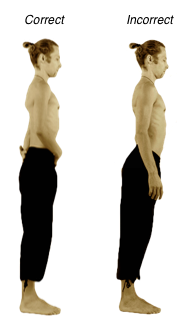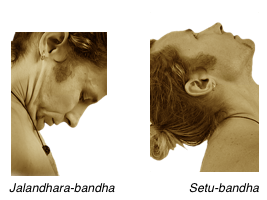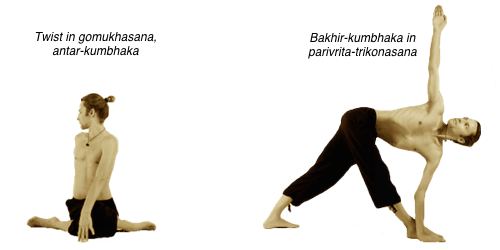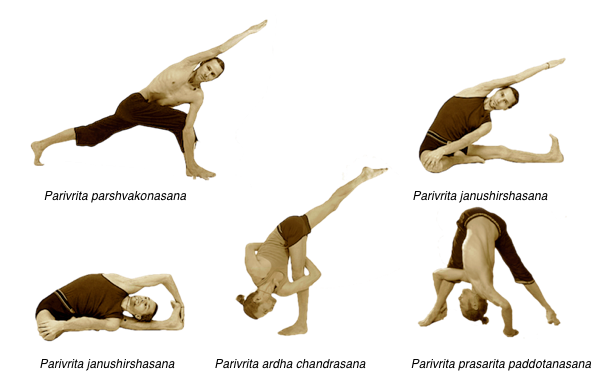Mikhail Baranov. "Kumbhaka in asanas". Part one
Prana and energy of vitality
“Prana” is “a primary vital energy” (has Sanskrit root “Ana” meaning “to revive, to vibrate” and prefix “pra” meaning “primary, standing ahead”).
Prana or vital force is characterized by movement (another variant of the origin of this word is “pra” - movement and “na” - constancy). All kinds of movement in a body are carried out by ten prana vayu. Vayu means “wind”, prana-vayu means “vital winds”; they personify all physical and mental functions. Circulation of ten pranas in a body is not chaotic, it is subjected to a certain order; when natural order of the movement is disturbed disbalance arises which is followed by disease. Ways of prana-vayu movement form a network of subtle energetic channels – nadi; to be exact a network of nadi channels arises and exists due to the presence of prana. Impurity of nadi is expressed in turbidity of perception, a state when the mind is incapable to distinguish correctly. Reasons of impurity can be different starting from drugs and alcohol abuse up to adverse ecology and social stresses. The general result is inability “to fully digest and acquire” life impressions.
Any vital activity of a person, whether it is a trench excavation or mathematical calculation of formulas for trench excavation, narcotic intoxication or meditation, is accompanied by corresponding nervous impulses. Difference between the mentioned states is not only in intensity of work of the brain, but also in a degree of sensible involvement into the process. Sensibleness does not appear just like this, but it is displayed as a result of steadiness of mind. Steadiness, or coolness, allows the mind to distinguish properly, not being involved in sensual reactions (“pleasant - not pleasant”). Depending on degree of coolness (which should not be confused with dullness generated by absence of sensitivity) it is possible to develop brain capabilities while excavating a trench if it is possible to keep concentration, “to keep the mind on one point”.
Everything arises due to reasons and conditions.
The concept of prana vayu illustrates interrelation of mental and physical processes. Prana, first of all, is expressed through breathing. A restless mind generates uneasy breathing and vice versa if breathing is unbalanced then mind is not concentrated. An excited mind tends to wander, wandering leads to dispersion of attention, inertness and automatism. Development of coolness in relation to distracting factors creates preconditions for deepening concentration on one object or process. Ancient yogis noticed that any action demanding mental concentration “automatically” calms down breathing, doing it more superficial, and on the contrary, intended lengthening of breathing promotes immersing into the state of concentration. Based on these observations a set of techniques appeared in yoga, in particular, pranayama, where control over breathing is used for creating favorable mental conditions and mental functions necessary for the occurrence of a steady concentration (pratyahara, dharana, dhyana) and, finally, samadhi. “When breath is moving, then mind is also unstable. Constraining his breath a yogi reaches stability of mind” (“Hatha Yoga Pradipika”, 2.2). Activity of prana vayu is counterbalanced by means of kumbhaka, thus “prana supervises the mind”, and therefore the basic method of pranayama is kumbhaka, a breath delay, or termination of inhales and exhales. Modern scientific researches show that active involvement of respiratory muscles promotes the state of wakefulness. Conditions ensuring physical health and mental balance are created by gradual development of control over pranamaya-kosha (an energy body).
Kumbhaka
When ten prana-vayu are free of impurities kevala-kumbhaka becomes possible (kevala means “absolute”, “complete”). It arises without any physical efforts of a practitioner, and in a context of hatha yoga practice it is identified with the state of samadhi. Until this moment sahita-kumbhaka is carried out (sahita – “supported”). All hypoxic hatha yoga exercises concern to sahita-kumbhaka. Sahita-kumbhaka is used in training practice for purposes of clarifying prana-vayu and developing control over prana, it does not interfere and does not contradict its wide therapeutic application.
Kumbha means “a vessel”. While performing breath delay a body becomes similar to a vessel filled with prana. Not to allow prana “to flow out” of a vessel bandhas are carried out. Bandha literally means “a lock”, “contraction”, “retention”, and also “a dam”, “binding”, “thickening”. Without proper application of bandhas performance of kumbhaka becomes ineffective and dangerous, and in cases of excessive enthusiasm it is fraught with serious psychosomatic disorders. In popular literature bandhas are often called “energy locks” as they promote energy accumulation in a body. We will try to understand how it happens.
Bandhas

On physical level bandha is fulfilled due to simultaneous contraction of several specific groups of muscles (thereupon meanings of the word bandha become clear - "a dam" and "thickening"). Dynamic performance of bandhas causes a micropump activity of skeletal muscles and thus amplifies local blood supply. It is well-known that there are three main bandhas: mula, uddiyana and jalandhara. They help to isolate the whole middle part of a body, and in this case the diaphragm plays the role of the main “pump”. Uddiyana-bandha causes a negative pressure in abdomen cavity, thorax and throat area and increases outflow of venous blood from internal organs, and thus, uddiyana plays a role of “the second heart”. At consecutive dynamic performance of uddiyana this effect amplifies and blood supply of tissues and organs considerably improves. Due to improved tissue breathing stagnant processes are prevented and detoxication is amplified. Muscular bandhas in other parts of a body operate in a similar way; the role of pumps is played by muscles located around the articulate complex. For example, janu-bandha is carried out at the expense of simultaneous contraction of muscles stabilizing a knee joint. Besides pelvis diaphragm, iliolumbar and abdominal muscles can be involved in mula-bandha.
Pelvis diaphragm is easier to contract properly if pelvis "is closed" and mula-bandha is done with involvement of iliolumbar and abdominal muscles:

Intensifying blood circulation and movement of liquids is only one aspect of dynamic application of bandhas. Their main purpose is maintenance of kumbhaka which causes a local accumulation of carbonic gas, as a result an organism acquires oxygen better, and this is the effect of cellular breathing. Pranayama practice with the help of bandhas counterbalances the work of sympathetic and parasympathetic parts of CNS; the dynamics of breathing is being controlled, due to that even during long delays short length of breathing is being remained. For example, jalandhara-bandha is used on a delay after inhalation; signal coming from the carotid artery after it is influenced arrives to respiratory centre, causes the expansion of bronchi and decrease in frequency of palpitation.
In due course work of endocrine systems also improves due to the optimization of work of vegetative nervous system and haemodynamic influence of bandhas on endocrine glands.
Reasons for using kumbhaka in asanas
Intensified effect from asana performance
During the correct performance of asanas bandhas appear naturally, due to a change of body configuration. It is possible to present a human body as an interconnected system of cavities filled with various liquids and gases. In the process of asana practice volume of these cavities and internal pressure are being changed, blood flow changes and metabolism improves. Manipulating with bandhas it is possible to intensify influence of asanas on blood circulation or, in some cases, on the contrary, to weaken it.
Rehabilitation
The main source of pain in asana is a muscle hypertonus. Its reasons can be different. The most frequent reason is an excessive training. Failures of blood circulation arising in case of overstrain in long fixation of asanas can be liquidated by a timely application of bandhas which considerably improves supply of tissues with oxygen and necessary nutrients. For this reason bandhas are used in yoga therapy as they accelerate rehabilitation after traumas when mechanical loading of the damaged area is contraindicated and full variant of asana is impossible.
Main principles of kumbhaka’s application
Langhana and brimhana
How should kumbhaka be used in asanas to multiply their effect? Main principles of kumbhaka’s use are explained within the concept of brimhana and langhana. Brimhana is “a means making something strong” as well as the process of “makings something strong”. Т.К.V. Desikachar explains brimhana in a context of hatha-yoga practice as “an expansion” which compensates the lack of energy. Langhana means “humility”, “reduction”, “fasting”, on its influence it is opposite to brimhana.
Kumbhaka being a development of inhalation or exhalation is supported by three core bandhas. Lengthening of exhalation in its limited development is expressed by application of bahir-kumbhaka - “an external” retention of breath connected with “consolidation and replacement” of prana out of body limits. Bahir-kumbhaka is carried out together with uddiyana-bandha and in character of its influence represents the principle of langhana. On retention after exhalation widely known cleaning kriyas are carried out - agnisara-dhauti and nauli which activate processes of detoxication, helping to remove products of metabolism out of an organism and to decrease body weight. With a reference to asana practice the accent made on exhalation helps to better feel and control the lower part of a trunk that promotes faster mastering of mula-bandha.
Lengthening of inhalation with subsequent antar-kumbhaka (“internal" retention connected with “accumulation” of prana in a body) corresponds to brimhana. This type of retention quickly warms up the body and gives a lot of energy, but for correct application in asanas it demands control over the quite developed intercostal respiratory muscles. Typical error among the beginners is that they close the glottal slit during the breath retention on inhalation (as it is more difficult to make it due to thorax expansion), it leads to failures of venous outflow and increases arterial pressure. Long exhalation is especially important for compensation of retention made after inhalation. While fulfilling uddiyana-bandha receptors of the vagus nerve react on pressure rise in abdomen cavity, this signal arrives to the respiratory centre located in myelencephalon and as a result sympathetic tonus goes down, arterial pressure and pulse rate decrease. Effect from bahir-kumbhaka depends on a character of influence on the vagus nerve. For example, during agnisara-dhauti and nauli nervous receptors are irritated stronger, therefore palpitation, on the contrary, increases and mobilization of organism resources characteristic for stressful situations takes place. Proper application of uddiyana-bandha in asanas allows to better supervise dynamics of breathing without increasing a sympathetic tonus.
What type of kumbhaka in which asana?
During asana practice the column and joints are exposed to different types of influences. It is important to understand in every concrete asana what part of the column or joint is being influenced and how (extension, compression, twisting, displacement or their combination). In the course of breathing the column is naturally stretched with inhalation and compressed with exhalation. During inhalation there is a small decompression in vertebras due to expansion and pressure increase in thorax and abdomen cavity and during exhalation - on the contrary.
Antar-kumbhaka intensifies decompression, bahir-kumbhaka intensifies compression.
In those asanas where there is no strong compression or displacement in the column, any variant of kumbhaka is possible. In other cases only one of its variants is used or it is not used at all.
1. Kumbhaka is supported by bandhas. If there is no possibility to use core bandhas or it is limited by the configuration of an asana, or by its specific effect, kumbhaka is not fulfilled.
2. In asanas with compression, displacement or twisting antar-kumbhaka is used as it is softening compression.
3. In asanas with a steady extension of the column (without strong twisting, compression or bending, i.e. displacement) and with a possibility to perform core bandhas, both types of breath retention are used: bahir-kumbhaka - for lowering sympathetic tonus and stabilizing of an articulate complex, antar-kumbhaka - for decompression and training of respiratory muscles (prana-vyayamas).
The majority of standing poses, sitting poses and forward bendings (mild) concern to asanas where the column is rather unloaded.
Displacement of intervertebral disks happens as a result of compression that to some extent occurs in all back bending, deep forward bending positions (yoganidrasana) and twists.
Antar-kumbhaka can be used in back bendings but without jalandhara-bandha and with an open glottis slit - such variant exists in the system of sukshma-vyayama exercises for training intercostal respiratory muscles. It is more complicated concerning retentions after exhalation. Bahir-kumbhaka with uddiyana-bandha cannot be performed in back bending postures with the support of hands when the broadest back muscles are involved and thorax is flattered, as flattered thorax does not allow diaphragm to lift up. But if the back bending is carried out without the support of hands, it is quite possible to do uddiyana.
In deep forward bendings, like dvipada shirshasana, the column is not only stretched, but it is compressed as well (lumbar lordosis smoothes out); the arising compression can be eased with the help of antar-kumbhaka.
In twisting postures that fulfilled without the help of arms both types of breath retention can be used. In other variants it is important to fix properly pelvis position - lumbar is extended and twisting occurs mainly in thoracic part in the area of floating ribs. If for various reasons an accent of twisting is put on the lumbar, compression should be compensated by antar-kumbhaka with mula-bandha or deep diaphragm breathing with accented inhalation.
Coordination of movement and breathing
Kumbhaka is the development of inhalation and exhalation and supported by bandhas, it is important to understand patterns of breathing in asanas before applying it in asana practice. There are certain rules of coordination between movement and breathing at the moment of entering asana and exiting it. Different schools teach differently: various variants are offered depending on style, mode of performance and special indications. At first we will consider the most common recommendations, and then some rule exceptions.
One general important rule:
Extension is obligatory for preparation for almost all asanas involving a direct work with the column, therefore:
For safety of intervertebral cartilages an additional space should be created between vertebras due to longitudinal (axial) extension of the column before performing forward, back or side bending, or twisting. Mula-bandha here involves lumbar-ileac and abdominal muscles and allows stabilizing and securing the lumbar.
Extension can be made both on inhalation and exhalation depending on concrete asana.
Rules of harmonizing movement, breathing and bandha application:
1. Forward and side bendings: dynamic entering into a bending in any position is carried out on exhalation.
It is known, that forward bendings “calm down” - increase of pressure in abdominal cavity influences wandering nerve which causes a fall of sympathetic tonus. Uddiyana-bandha strengthens this effect.
Side bendings do not lower sympathetic tonus; in this position uddiyana promotes the best stretching of sacroiliac muscles and ligaments in the basis of the back.
2. Back bendings and extensions: there are ways of entering bendings on inhalation and exhalation.
The primary task while entering the bending on inhalation is to keep the lumbar extended as much as possible, that is possible if you manage to keep lumbar and pelvic muscles contracted - in other words if bending entrance is carried out on inhalation then mula-bandha should be done stabilizing the lumbar part. For the majority of beginners it is easier to control bandhas on exhalation, therefore for safe and correct mastering it is possible to use this variant, but without uddiyana-bandha.
3. Twisting
Twists are carried out on exhalation, after the preliminary longitudinal extension of the column on inhalation. During the correct twisting lumbar part should remain extended and twisting in it should be minimum, therefore uddiyana and mula-bandhas use will be justified as they help to designate twisting borders in the lumbar.
If twisting is carried out with the use of arms then compression increases; an attempt to make uddiyana-bandha additionally increases compression which is fraught with traumas. Thus, uddiyana-bandha serves as a natural limiter of twisting in lumbar part. In deep twistings antar-kumbhaka or deep diafragm breathing is used for decompression.
fragm breathing is used for decompression.
4. Combination of twisting and bending
In those not numerous asanas where bending is combined with twisting and simultaneous extension of the column uddiyana-bandha can be done.
Bendings considerably raise the tonus of sympathetic nervous system, uddiyana-bandha, on the contrary, lowers it, helping to supervise breathing. In deep bendings, for example in chakrasana, it is extremely difficult to do uddiyana-bandha and in the most of the cases it is not needed, obviously, such variant can be used only by the advanced practitioners.
5. Twisting with bending
Twisting in forward bending takes place not only in a well-known parivrita konasana, parivrita janushirshasana, and parivrita ardha chandranasana but also in a less known variant of parivrita prasarita padottanasana.
Twisting in bending is also used in forward bendings with twisting in coxofemoral joints.
A general prominent feature of this type of twistings is a strong extension in lumbar part that is why it will be effective to alternate mula-bandha and uddiyana-bandha at their performance.
To be continued in Part 2 (next issue).






